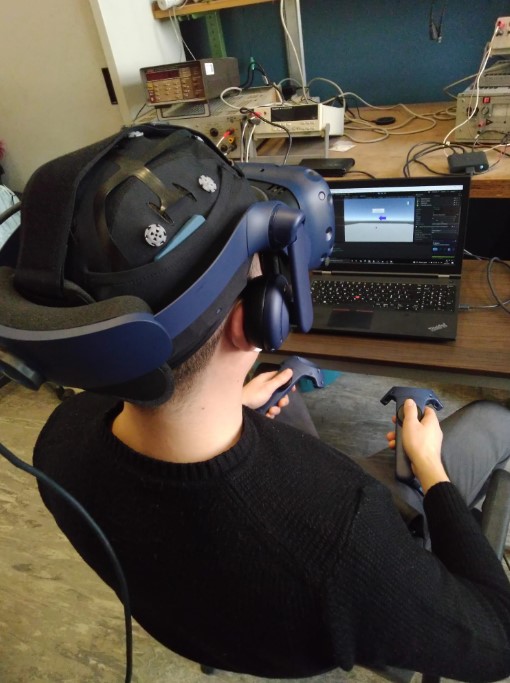
Application field
Rehabilitation, gaming, control
Technology
Electroencephalography (EEG), artificial intelligence, extended reality
Goals
Development of a fully wearable brain-computer interface system based on motor imagery that leverages multiple modalities of extended reality delivered neurofeedback.
The aims are to enhance the detection of the user's sensorimotor rhythms and to speed up motor imagery skills acquisition. Different types of feedback are delivered both as standalone or jointly by relying on the results of online processing of brain signal.
Activities
- Development of artifact removal technique for low density EEG.
- Evaluation of motor imagery EEG feature extraction and classification algorithms exploiting both classic machine learning and deep learning approaches.
- Classification of multiple motor imagery tasks.
- Development of extended reality applications to deliver neurofeedback.
- Design and implementation of experimental campaigns.
- Metrological analysis of the results.
Challenges
- Improving results accuracy, repeatability and reproducibility.
- Implementation of a user-friendly neural interface addressed to tele-rehabilitation, gaming or control.
Bibliography
- Arpaia, P., Coyle, D., Donnarumma, F., Esposito, A., Natalizio, A., & Parvis, M. (2022). Visual and haptic feedback in detecting motor imagery within a wearable brain-computer interface. Measurement, 112304.
- Arpaia, P., Esposito, A., Natalizio, A., & Parvis, M. (2022). How to successfully classify EEG in motor imagery BCI: a metrological analysis of the state of the art. Journal of Neural Engineering.
- Arpaia, P., Coyle, D., Donnarumma, F., Esposito, A., Natalizio, A., Parvis, M., ... & Vallefuoco, E. (2022, October). Multimodal Feedback in Assisting a Wearable Brain-Computer Interface Based on Motor Imagery. In 2022 IEEE International Conference on Metrology for Extended Reality, Artificial Intelligence and Neural Engineering (MetroXRAINE) (pp. 691-696). IEEE.
- Arpaia, P., D’Angelo, M., D’Errico, G., De Paolis, L. T., Esposito, A., Grassini, S., ... & Nuzzo, B. L. (2022, October). EEG features of the interaction between sense of agency and body ownership: a motor imagery BCI case study. In 2022 IEEE International Conference on Metrology for Extended Reality, Artificial Intelligence and Neural Engineering (MetroXRAINE) (pp. 104-109). IEEE.
- Arpaia, P., De Bendetto, E., Esposito, A., Natalizio, A., Parvis, M., & Pesola, M. (2022, June). Comparing artifact removal techniques for daily-life electroencephalography with few channels. In 2022 IEEE International Symposium on Medical Measurements and Applications (MeMeA) (pp. 1-6). IEEE.
- Arpaia, P., Coyle, D., Donnarumma, F., Esposito, A., Natalizio, A., & Parvis, M. (2022). Non-immersive Versus Immersive Extended Reality for Motor Imagery Neurofeedback Within a Brain-Computer Interfaces. In International Conference on Extended Reality (pp. 407-419). Springer, Cham.
- Arpaia, P., Esposito, A., Mancino, F., Moccaldi, N., & Natalizio, A. (2021, September). Active and passive brain-computer interfaces integrated with extended reality for applications in health 4.0. In International Conference on Augmented Reality, Virtual Reality and Computer Graphics (pp. 392-405). Springer, Cham.
- Angrisani, L., Arpaia, P., Esposito, A., Gargiulo, L., Natalizio, A., Mastrati, G., ... & Parvis, M. (2021). Passive and active brain-computer interfaces for rehabilitation in health 4.0. Measurement: Sensors, 18, 100246.
- Arpaia, P., Donnarumma, F., Esposito, A., & Parvis, M. (2021). Channel selection for optimal EEG measurement in motor imagery-based brain-computer interfaces. International Journal of Neural Systems, 31(03), 2150003.
Angrisani, L., Arpaia, P., Donnarumma, F., Esposito, A., Frosolone, M., Improta, G., ... & Parvis, M. (2020, May). Instrumentation for Motor Imagery-based Brain Computer Interfaces relying on dry electrodes: a functional analysis. In 2020 IEEE International Instrumentation and Measurement Technology Conference (I2MTC) (pp. 1-6). IEEE.





